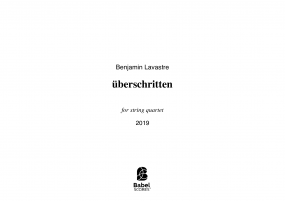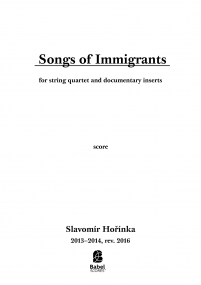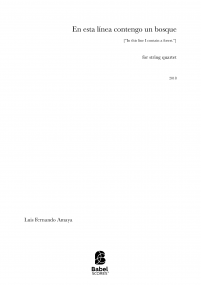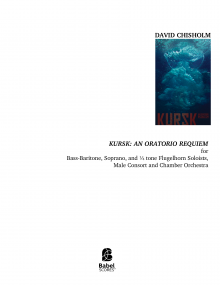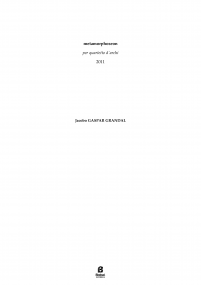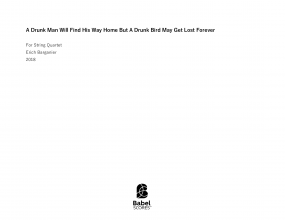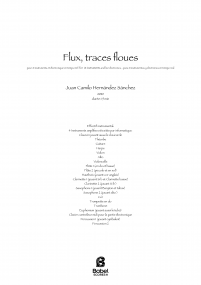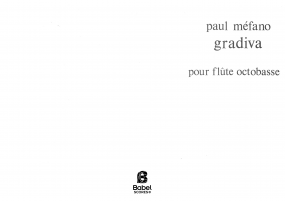Recherche avancée
Pèlerinage Fantastique
'Fantastic Pilgrimage' for prepared string quartet (12') (2010/12)
10,30 €
Version numérique (+0,00 €) à télécharger
Version papier (+14,80 € impression et livraison ). Colissimo7-14 days aprox.
Chez BabelScores, quand vous achetez une partition, vous pouvez ensuite contacter directement le compositeur ici même !
Caractéristiques
Region
Europe
Estimated Duration
11 - 15min
Date
2012
ISMN : 979-0-2325-0275-5
In Stock
Notes sur cette pièce The main idea behind the piece is to invite the imagination of both musicians and listeners to a fantastic journey or pilgrimage, be it an outer journey to some wondrous place or an inner journey to the miracles of our inner lives.
At the same time, the work can be regarded as a fantastic or visionary pilgrimage to the rich extended sound world of the prepared string quartet involving a large variety of different musical characters, climaxes, anticlimaxes and surprises, as a result of the working process by the composer feeling his way through the wild jungle of the untamed sonic material. The relation of the French title Pèlerinage Fantastique to the two great romantic masters Franz Liszt (Années de Pèlerinage) and Hector Berlioz (Symphonie Fantastique) thus concerns both their deep and optimistic belief in musical progress as well as their idea of programme music, whereas there is no explicit programme in this piece beyond the above-mentioned.
In case the string quartet players surround the audience during the performance, the pilgrimage can also be regarded as a journey to the acoustic characteristics of the room.
On a more technical musical level the composition undergoes a timbral pilgrimage in 3 equally long parts from discontinuous, percussive and repetitive to continuous and sustained sounds. The 1st part on the one hand mainly exposes plucked and struck sounds (pizzicato, battuto) and thus embodies the timbral discontinuities. The 3rd part on the other hand basically presents bowed sounds (tratto), i.e. the timbral continuities. The predominant sounds of the 2nd part, bowed sounds obtained either through high bowing pressure or by unconventional sound producing means, can be perceived as repetitive continuities or continuous repetitions. Thus they serve as a timbral link in macroform between parts 1 and 3.
In microform, 3 more links between the 3 parts can be recognized: Firstly, all 3 parts start and end with and include insertions of a 4th musical structure which grow longer and longer to the end of the piece: the playing with a bamboo knitting needle woven through the strings. While the needle is solely "bowed" in the beginning of part 1, its treatment more and more comprises vibrant plucking attacks. This development from continuities to discontinuities creates tension in relation to the opposite process in macrofrom.
Secondly, all 3 parts contain insertions of musical material from the respective 2 other parts. These insertions are longest in the close neighbourhood to their origin and shortest in the greatest distance to it.
Thirdly, in accordance with the silent and mysterious beginning and ending of the bowed knitting needle, all 3 parts reach their dynamic climaxes quite exactly in their respective middles.
The performance begins when the musicians start to "insert" the knitting needles into their instruments by threading them through the strings. The piece is over when the players simultaneously pull out the knitting needles from the strings evoking the idea of total standstill and silence.
Commission: Composed for a workshop with the Arditti String Quartet in London / GreatBritain, 2010.
Ajouter à une playlist
- Identifiez-vous pour créer une liste
At the same time, the work can be regarded as a fantastic or visionary pilgrimage to the rich extended sound world of the prepared string quartet involving a large variety of different musical characters, climaxes, anticlimaxes and surprises, as a result of the working process by the composer feeling his way through the wild jungle of the untamed sonic material. The relation of the French title Pèlerinage Fantastique to the two great romantic masters Franz Liszt (Années de Pèlerinage) and Hector Berlioz (Symphonie Fantastique) thus concerns both their deep and optimistic belief in musical progress as well as their idea of programme music, whereas there is no explicit programme in this piece beyond the above-mentioned.
In case the string quartet players surround the audience during the performance, the pilgrimage can also be regarded as a journey to the acoustic characteristics of the room.
On a more technical musical level the composition undergoes a timbral pilgrimage in 3 equally long parts from discontinuous, percussive and repetitive to continuous and sustained sounds. The 1st part on the one hand mainly exposes plucked and struck sounds (pizzicato, battuto) and thus embodies the timbral discontinuities. The 3rd part on the other hand basically presents bowed sounds (tratto), i.e. the timbral continuities. The predominant sounds of the 2nd part, bowed sounds obtained either through high bowing pressure or by unconventional sound producing means, can be perceived as repetitive continuities or continuous repetitions. Thus they serve as a timbral link in macroform between parts 1 and 3.
In microform, 3 more links between the 3 parts can be recognized: Firstly, all 3 parts start and end with and include insertions of a 4th musical structure which grow longer and longer to the end of the piece: the playing with a bamboo knitting needle woven through the strings. While the needle is solely "bowed" in the beginning of part 1, its treatment more and more comprises vibrant plucking attacks. This development from continuities to discontinuities creates tension in relation to the opposite process in macrofrom.
Secondly, all 3 parts contain insertions of musical material from the respective 2 other parts. These insertions are longest in the close neighbourhood to their origin and shortest in the greatest distance to it.
Thirdly, in accordance with the silent and mysterious beginning and ending of the bowed knitting needle, all 3 parts reach their dynamic climaxes quite exactly in their respective middles.
The performance begins when the musicians start to "insert" the knitting needles into their instruments by threading them through the strings. The piece is over when the players simultaneously pull out the knitting needles from the strings evoking the idea of total standstill and silence.
Commission: Composed for a workshop with the Arditti String Quartet in London / GreatBritain, 2010.
Instrumentation
Violin (2)|Viola |Cello
Recording
2011-03-12 - Kairos Quartet in Klosterneuburg / Vienna (Aut) - final concert of ZEITklang competition 2011.
Score Details
Format - A4 / US Letter
Pages - 60
Pages - 60



